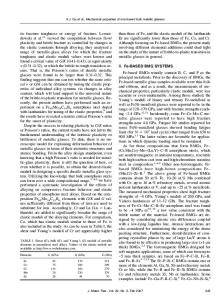Bulk Scandium-based Metallic Glasses
- PDF / 298,812 Bytes
- 5 Pages / 612 x 792 pts (letter) Page_size
- 0 Downloads / 509 Views
Bulk scandium-based metallic glasses X.K. Xi, S. Li, R.J. Wang, D.Q. Zhao, M.X. Pan, and W.H. Wanga) Institute of Physics, Chinese Academy of Sciences, Beijing 100080, China (Received 2 November 2004; accepted 19 May 2005)
The novel rare-earth scandium-based bulk metallic glasses (BMGs) are obtained by the copper mold casting method. Compared with other rare-earth BMGs reported so far, the Sc-based BMGs exhibit the highest elastic moduli (e.g., Young’s modulus, E ⳱ 85 GPa; bulk modulus, B ⳱ 77.5 GPa), glass transition temperature (Tg ⳱ 662 K), and crystallization temperature (Tx ⳱ 760 K) combined with a large region of supercooled liquid (⌬T = 98 K). A good correlation between glass transition temperature and elastic moduli is found in a variety of rare-earth-based BMGs.
Intensive interest has been focused on investigating the metallic rare-earth (RE)-based bulk metallic glasses (BMGs) because of their technological and fundamental significance.1–7 Recently, we reported that the Pr(Nd)– (Ni,Cu)–Al3 and Ce–Al–(Ni,Cu)–(Nb,Co,Fe)6 BMGs with high glass-forming ability (GFA) and ultralow glass-transition temperature (Tg) close to room temperature can be readily cast in bulk forms by the copper mold casting method (the GFA is usually defined as the critical cooling rate needed for the glass formation during solidification1). The GFA of these alloys is high enough to produce BMGs with critical thicknesses on the order of centimeters.3–7 However, structural relaxation occurs in these low Tg glassy alloys even at ambient temperature and pressure, which would limit some applications. Previous studies have shown that there is a tendency for Tg to increase with increasing bulk modulus of the base element in the alloy.8,9 To produce RE-based metallic glasses with higher glass transition temperature and crystallization temperature, in other words, to improve thermal stability, we tried to produce scandium-based BMGs. In the rare-earth family, Sc has a higher bulk modulus (B ⳱ 57 GPa)10 and melting temperature (Tm ⳱ 1814 K),10 the lowest density (2.702 g/cm3),10 the smallest atomic size (0.162 nm),10 and a relatively low chemical activity. If the glassy structure can be formed, the Sc-based BMGs could have high Tg and unique elastic and mechanical properties. Furthermore, Sc–TM (TM ⳱ Fe, Co, Ni) glassy films were found to have a)
Address all correspondence to this author. e-mail: [email protected] DOI: 10.1557/JMR.2005.0281 J. Mater. Res., Vol. 20, No. 9, Sep 2005
http://journals.cambridge.org
Downloaded: 14 Mar 2015
excellent magnetic transportation cooling effects, which is the change in temperature of a material as a result of the alignment of its magnetic spins that occurs on exposure to an external magnetic field, and the effect forms the basis for magnetic refrigeration.11,12 Therefore, the Sc-based BMGs might be attractive for scientific studies and application as functional materials. The formation of Sc–Co and Sc–Fe binary metallic glassy ribbons with poor GFA was reported in 1990s.11–13 Based on the results, in
Data Loading...











